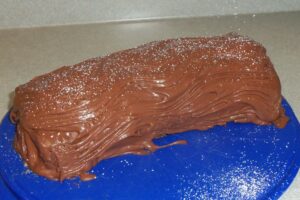 Note from Cat: I’m so pleased to see Be The Sea out in print. I read an early version and it’s a lovely book. Please pick it up or request it through your local library!
Note from Cat: I’m so pleased to see Be The Sea out in print. I read an early version and it’s a lovely book. Please pick it up or request it through your local library!
A Yule log cake features prominently in my new novel, Be the Sea. While preparing it, four characters share bits of their history involving kitchens and cooking.
Kai, an outgoing enby poly pansexual from Hawai’i says, “Where I grew up, I loved everyone’s kitchen except mine.”
Aljon, a quiet ace sailor turned ship’s cook from the Philippines responds, “I felt safe in our kitchen and extended that to others.”
They’re both vegan, and Matt, who loves to feed people and is simultaneously making his second and third cakes for Yule, is Pagan. So the cake they make together is vegan, filled with pistachio cream spiraled inside chocolate cake. It’s frosted with whipped chocolate, applied in thick swoops with a knife, then textured using the tines of a fork to resemble bark. Powdered sugar is dusted on top as if there’s been a light winter snow; after all, this is a Yule log cake.
In truth, my household makes the same cake fashioned as…a groundhog.

Why? What’s the truth behind my fictional cake?
First, like my story’s point of view character, Wend, I love chocolate but grew up with a single mom who had little interest in or time for cooking, let alone baking. Second, and completely unrelated to my novel, my mom had a peculiar obsession with Groundhog Day (the holiday, not the movie). As she told it, this arose from a chance encounter with a newspaper reporter in San Francisco in the ‘60s who was asking passersby on the street if they knew what day it was. Evidently, the moment in my mom’s life when she felt most seen and affirmed was when she answered correctly that it was February 2nd, Groundhog Day.
I will never know if my mom would have identified as enby or ace (although I have my suspicions) because she passed away in the early ‘90s. What I know is that she made exactly one kind of cake. I don’t make it the same way she did, but once a year, for Groundhog Day, my chosen family chooses from several options for chocolate roll cakes. The tines of a fork pluck at the frosting until it looks like fur. A diagonal slice through the center makes one cake into two, each with a sloped face that can be decorated with nuts for ears and jellybeans for eyes.
In different times and different kitchens, each of us may share our own truths. We will see the same cake in new and different ways. And sometimes, in the eyes of a reporter or a groundhog, we will feel seen.

Choose your own—traditional, vegan, gluten-free, or nut-free—log or critter cake:
1) Cake
Preheat oven to 350 F. Line a 17×20” jelly roll pan with greased parchment (flour top if not gluten-free).
Baking for a traditional or gluten-free party? Jump to 1a.
Let’s make it vegan! Jump to 1b.
1a) Melt 4 oz melted bittersweet chocolate and allow it to cool a bit. In a mixing bowl, beat ¼ cup sugar and 6 egg yolks together for 5 minutes. Beat in chocolate, scrape down sides, blend until consistent.
In a separate mixing bowl, beat 6 egg whites until bubbly, add ¾ tsp cream of tartar, and beat until soft peaks form. Add 2 Tbsp sugar and beat until stiff peaks form. Fold into chocolate mixture a quarter at a time. Pour into prepared pan and bake 15 minutes (or until not shiny and center springs back when touched). Sprinkle with 1 Tbsp unsweetened cocoa and cover with damp towel while it cools. Jump to 2.
1b) Blend in a food processor until finely ground: 4 oz flour, 4 oz sugar, 4 oz unsweetened chocolate, and 2 oz blanched hazelnuts. Place in a sealed container in the freezer for at least an hour.
Mix until stiff peaks form: 12 oz water, 8 oz sugar, ¼ oz Versawhip (modified soy protein), and ¼ tsp xanthan gum. Refrigerate for at least an hour. Rewhip and quickly fold in chocolate mixture from freezer. Pour into a prepared pan and bake for 20 minutes (or until center springs back when touched). Sprinkle with 1 Tbsp unsweetened cocoa and cover with damp towel while it cools. Jump to 2.
2) Filling
Pull out yet another mixing bowl.
Stay nut-free with a traditional whipped cream filling! Jump to 2a.
Choose your favorite nuts (pistachio, walnut, cashew…) and stay vegan. Jump to 2b.
2a) Whip until soft peaks form: 1½ cup extra heavy whipping cream, 1½ Tbsp sugar, and ½ tsp vanilla (may use gelatin, agar agar, or Cobasan to stabilize if desired). Jump to 3.
2b) Blend 4 cups nuts, ½ cup maple syrup, seeds from 1 vanilla bean, and ½ cup water in a food processor until fluffy. Chill. (If using hard nuts like pistachios or cashews, it helps to soak them for 4 hours ahead of time with the vanilla bean slit open in the same water.) Jump to 3.
3) Frosting
Craving a classic creamy chocolate? Jump to 3a.
For intense vegan chocolate frosting that requires almost nothing beyond chocolate and finesse: Jump to 3b.
3a) Run 12 oz of your favorite bittersweet chocolate in a food processor until very fine. Keep that running as you pour 1½ cups of nearly boiling heavy whipping cream in a steady stream. (Adding ¼ cup more cream will make it fudgier. Adding ¼ cup of room temperature butter at the end will make it fluffier.) Cool completely once smooth. Jump to 4.
3b) Whip 9 oz of very hot water into 12 oz of melted bittersweet chocolate. Place in ice bath and whip until spreadable. (May be best to prepare this option after you roll the cake and spread immediately.) Jump to 4.
4) Bakers Assemble!
Spread the filling evenly onto the cake. Use the parchment to lift one long edge and roll, pulling back the parchment as you go. Refrigerate for one hour before slicing center diagonally (if desired for face or other decoration).
Spread with frosting, texture with a fork, and add candy or nut features to create the final—jump off the page to your own creativity!
Author bio:
 Clara Ward lives in Silicon Valley on the border between reality and speculative fiction. Their latest novel, Be the Sea, features a near-future ocean voyage, chosen family, and sea creature perspectives, while delving into our oceans, our selves, and how all futures intertwine. Their short fiction has appeared in Strange Horizons, Decoded Pride, Small Wonders, and as a postcard from Thinking Ink Press. When not using words to teach or tell stories, Clara uses wood, fiber, and glass to make practical or completely impractical objects. More of their words along with crafted creations can be found at https://clarawardauthor.wordpress.com and their short stories can be found at https://clarawardauthor.wordpress.com/short-stories/
Clara Ward lives in Silicon Valley on the border between reality and speculative fiction. Their latest novel, Be the Sea, features a near-future ocean voyage, chosen family, and sea creature perspectives, while delving into our oceans, our selves, and how all futures intertwine. Their short fiction has appeared in Strange Horizons, Decoded Pride, Small Wonders, and as a postcard from Thinking Ink Press. When not using words to teach or tell stories, Clara uses wood, fiber, and glass to make practical or completely impractical objects. More of their words along with crafted creations can be found at https://clarawardauthor.wordpress.com and their short stories can be found at https://clarawardauthor.wordpress.com/short-stories/













One Response